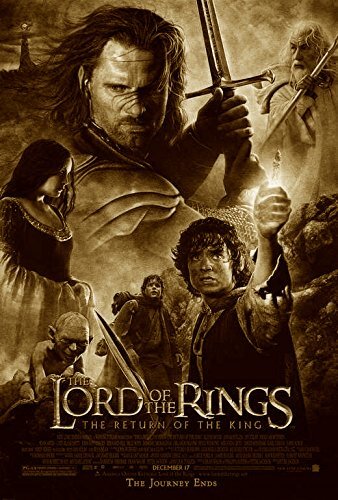PHENOMENALITY: *marvelous*
MYTHICITY: *good*
FRYEAN MYTHOS: *adventure*
CAMPBELLIAN FUNCTION: *metaphysical, psychological, sociological*
Though I didn't like many of the changes the TWO TOWERS made to Tolkien's book, those in RETURN OF THE KING are largely justified. Within the context of a book, it wasn't wrong to devote pages and pages to the parallel encounters of Merry and Pippin with, respectively, good ruler Theoden and corrupted steward Denethor. But I'm very glad the film didn't devote so much time to those encounters. For instance, Film-Merry doesn't spend any time learning the ropes of Rohan's military service in the film; he just hangs around until it's time for him to fulfill his main role, that of rendering aid during Eowyn's struggle against the Witch-King of Angmar.
Gandalf's overt motive for taking Pippin to Gondor is the same-- to protect the Hobbit after he messed with the Palantir-- but the scenes in which Denethor rejects the re-ascension of the royal heir Aragorn seem to me more dramatically pleasing than in the book. Denethor clutches his possession of the Gondor throne in the same way that victims of the Ring become slaves of its power. Denethor's irrational rejection of his younger son Faramir in favor of a fantasy-memory of the late older son Boromir is also true to Tolkien's observations on evil's power for self-deception and self-annihilation.
In my review of RETURN, I complained that there was too little Gollum for my taste, even though I found the ending of TOWERS fully effective: the questing Hobbits separated after Gollum betrays them to the giant spider Shelob. Jackson and company chose not to end TOWERS on that doleful note, moving all the plotlines concerned with the Hobbits' entrance into Cirith Ungol into RETURN. This makes it possible for the film to build up Gollum's presence more than one sees in the third part of the trilogy. Jackson et al surely intended to give Gollum greater emphasis, given that RETURN begins with a flashback to Gollum's beginnings, when, as the Hobbit Smeagol, he murdered his near relation to possess the "precious" Ring of Power. By foregrounding the way Smeagol's life was ended by the sudden intrusion of irresistible Evil, the film makes clearer the irony that the Ring's evil is defeated in part by one of its own vessels.
I wasn't wild for TOWERS' many original scenes in which poor Eowyn pined after the unobtainable Aragorn. However, in RETURN Eowyn's ill-fated love works to strengthen the scene in which she masquerades as a male soldier to join the fight, and takes Merry into battle with her. Their importance to the story defies conventional wisdom as to war being the exclusive business of Men (as Aragorn tells Eowyn), but it's not some putdown of "the patriarchy." Rather, Eowyn and Merry should be thought of as "the stones the builder rejected," able to overcome superior forces of evil through sheer pertinacity. I didn't care for the book's scenes in which Eowyn "settled" for secondary hero Faramir, but the parallel scenes in the film are much shorter. Moreover, they're easier to take because the film's Faramir is more fallible than Tolkien's original.
In the books Saruman and his pawn Wormtongue cease to be major players in the conflict once Orthanc is destroyed, though Tolkien gets one last use out of them as poisonous influences upon the Hobbits' bucolic home in the Shire. But it makes sense to get rid of these secondary villains quickly within the context of a sprawling movie.
The Shelob-battle is given a different arrangement. Whereas in the book Gollum lures both Sam and Frodo into the spider's lair, Jackson has Gollum sow discord between the boon companions by playing upon Frodo's suspicions of anyone who might take the Ring from him. Frodo separates from Sam, allowing for lots of heady drama about friends parted, but Gollum can't resist trying for the Ring again. The two fight-- giving viewers a foretaste of their struggle in Mount Doom-- and for the first time Gollum learns that his "master" plans to destroy "the precious." As in the book Frodo still gets paralyzed by Shelob's sting and Sam manages to drive off the monster, though on this occasion Tolkien's description of the battle is better than the cinema version. From then on, most of the beats of Sam and Frodo's journey follow the book closely enough.
Jackson leaves out all the events of "the Scourging of the Shire." Yet a lengthy coda following the destruction of the Ring makes clear that both Frodo and Bilbo cannot go back to their old bucolic life, though they can receive the honor of passing into the Gray Havens of the Elves. This prefigures the passing of all the non-human inhabitants of Middle-Earth, as the Time of Men begins. Some found the coda too long, but it captures much of the melancholy of Tolkien's signature creation-- and that more than makes up for the few missteps along the way.

No comments:
Post a Comment